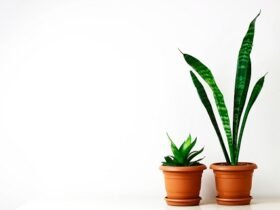The ZZ plant, scientifically known as Zamioculcas zamiifolia, has gained popularity as a beloved houseplant due to its hardiness and striking appearance. Native to Eastern Africa, this plant is known for its glossy, deep green leaves and its ability to thrive in low-light conditions. This care guide will delve into all aspects of ZZ plant maintenance, ensuring that your Zamioculcas remains healthy and vibrant.
Introduction to the ZZ Plant
Overview
The ZZ plant is an evergreen perennial that belongs to the Araceae family. It is admired for its feather-like leaves that grow upwards in a graceful, arching pattern. Each leaf is composed of numerous smaller leaflets, creating a lush and full appearance. The plant can grow up to 3 feet tall indoors, making it a substantial and eye-catching addition to any room.
Historical Background
The ZZ plant was first documented in botanical literature in the late 19th century, but it didn’t gain widespread popularity as a houseplant until the late 20th century. Its resilience and low maintenance requirements have made it a favorite among novice and experienced gardeners alike.
Light and Temperature Requirements
Light Needs
- Low to Bright Indirect Light: ZZ plants are highly adaptable and can tolerate a range of lighting conditions. They thrive in low to moderate indirect light, making them ideal for spaces with limited natural sunlight. However, they can also handle brighter indirect light, which may promote faster growth.
- Avoid Direct Sunlight: Direct sunlight can scorch the leaves, leading to discoloration and damage. If placed in a sunny spot, use sheer curtains to diffuse the light.
Temperature Preferences
- Ideal Temperature Range: ZZ plants prefer temperatures between 60°F and 75°F (15°C to 24°C). They can tolerate slightly cooler or warmer temperatures but should be kept away from drafts, air conditioning vents, and heaters.
- Humidity: While ZZ plants are not particularly fussy about humidity, they do best in moderate humidity levels. In very dry environments, consider using a humidifier or placing a tray of water near the plant to maintain moisture in the air.
Watering Schedule and Methods
Watering Frequency
- Infrequent Watering: One of the ZZ plant’s most appealing qualities is its drought tolerance. These plants have rhizomes that store water, allowing them to go for extended periods without watering. Generally, watering every 2-3 weeks is sufficient, but this can vary depending on the climate and season.
- Check Soil Moisture: Before watering, always check the soil moisture level. Stick your finger about an inch into the soil; if it feels dry, it’s time to water. Overwatering is one of the most common causes of ZZ plant decline, leading to root rot.
Watering Techniques
- Deep Watering: When watering, do so thoroughly until water drains out of the bottom of the pot. This ensures that the water reaches the root zone and promotes healthy root growth.
- Drainage: Ensure that the pot has adequate drainage holes to prevent water from sitting at the bottom, which can cause root rot.
Soil and Potting Mix
Soil Requirements
- Well-Draining Mix: ZZ plants prefer a well-draining soil mix to prevent water from pooling around the roots. A standard potting mix combined with perlite or sand works well.
- Soil Composition: A good mix might include two parts potting soil, one part perlite, and one part coarse sand. This combination provides the necessary drainage and aeration.
Potting and Repotting
- Choosing a Pot: Select a pot with drainage holes to facilitate proper water management. Terracotta pots are an excellent choice as they allow for better air circulation and moisture evaporation.
- Repotting Schedule: ZZ plants do not need frequent repotting. Typically, repotting every 2-3 years is adequate, or when the plant becomes root-bound. When repotting, choose a pot that is one size larger than the current one to provide room for growth.
Fertilization Tips
Fertilizer Types
- Balanced Liquid Fertilizer: Use a balanced, water-soluble fertilizer with an N-P-K ratio of 20-20-20. This ensures the plant receives an even distribution of essential nutrients.
- Slow-Release Fertilizer: Alternatively, slow-release granular fertilizers can provide a steady supply of nutrients over several months.
Fertilization Schedule
- Growing Season: Fertilize the ZZ plant during the growing season, typically from spring to early fall. Apply fertilizer once a month during this period.
- Dormant Season: Reduce or stop fertilizing in the winter months when the plant’s growth slows down. Over-fertilizing during this time can lead to nutrient buildup and potential root damage.
Common Pests and Diseases
Pests
- Spider Mites: These tiny pests can cause leaves to appear stippled or dusty. Regularly inspect the undersides of leaves and treat infestations with insecticidal soap or neem oil.
- Mealybugs: Mealybugs are small, white, cotton-like insects that can be found in the leaf axils. Remove them manually with a cotton swab dipped in alcohol or use insecticidal soap.
- Scale Insects: These pests appear as small, brown, immobile bumps on stems and leaves. Remove them with a soft brush or treat with horticultural oil.
Diseases
- Root Rot: Caused by overwatering, root rot is the most common disease affecting ZZ plants. Symptoms include yellowing leaves and a mushy stem base. To prevent root rot, ensure proper drainage and avoid overwatering.
- Leaf Spot: Fungal infections can cause dark spots on the leaves. Improve air circulation around the plant and avoid getting the leaves wet to prevent this issue.
Pruning and Propagation Techniques
Pruning
- Removing Dead or Yellowing Leaves: Regularly remove any dead, yellowing, or damaged leaves to keep the plant looking tidy and to prevent potential pest and disease issues.
- Shaping the Plant: Pruning can also be used to shape the plant and encourage fuller growth. Cut back any excessively long stems to maintain a balanced appearance.
Propagation Methods
- Division: The most straightforward method of propagation is by division. When repotting, gently separate the rhizomes and plant them in separate pots.
- Leaf Cuttings: ZZ plants can also be propagated from leaf cuttings. Cut a healthy leaf with a small portion of the stem attached and plant it in moist soil. Keep the soil consistently moist and place the cutting in indirect light until new growth appears.
- Stem Cuttings: Another method is to take stem cuttings with at least two leaves attached. Allow the cut end to dry for a few hours, then plant it in a well-draining soil mix. Water sparingly until new growth is observed.
Additional Tips for ZZ Plant Care
Cleaning the Leaves
- Dusting: Dust can accumulate on the leaves, blocking light and affecting photosynthesis. Gently wipe the leaves with a damp cloth to keep them clean and shiny.
- Misting: Occasional misting can help maintain humidity levels and keep the foliage looking fresh, but be careful not to overdo it as excessive moisture can lead to fungal issues.
Seasonal Care
- Winter Care: During the winter months, reduce watering and move the plant away from cold drafts. Ensure it still receives adequate light, as shorter days can affect growth.
- Summer Care: In the summer, ZZ plants may require more frequent watering due to increased evaporation. Monitor the soil moisture and adjust the watering schedule accordingly.
Troubleshooting Common Issues
- Yellowing Leaves: If the leaves turn yellow, it could be a sign of overwatering. Check the soil moisture and adjust the watering schedule. Ensure the pot has proper drainage.
- Leggy Growth: Leggy growth is often a result of insufficient light. Move the plant to a brighter location with indirect light to encourage more compact growth.
- Leaf Drop: Leaf drop can occur due to sudden temperature changes or drafts. Ensure the plant is kept in a stable environment with consistent temperatures.
FAQs about ZZ Plant Care Guide
Water your ZZ plant every 2-3 weeks, allowing the soil to dry out between waterings. Adjust the frequency based on the plant’s environment and seasonal changes.
Yes, ZZ plants are highly adaptable and can thrive in low light conditions. However, they will grow more slowly compared to when placed in brighter indirect light.
Inspect the plant regularly for pests such as spider mites, mealybugs, and scale insects. Treat infestations with insecticidal soap, neem oil, or by manually removing the pests with a cotton swab dipped in alcohol.
ZZ plants can be propagated through division, leaf cuttings, or stem cuttings. Division is the easiest method, but leaf and stem cuttings can also be successful with patience and proper care.
Yellow leaves are often a sign of overwatering. Ensure the soil dries out between waterings and check for proper drainage to prevent root rot.
ZZ plants can be kept outdoors in warm, shaded areas, but they should be brought indoors if temperatures drop below 60°F (15°C) to prevent cold damage.
Yes, ZZ plants are toxic if ingested by pets or humans. Keep the plant out of reach of children and pets to avoid any potential health issues.
If you suspect root rot, remove the plant from its pot, trim away any affected roots, and repot in fresh, well-draining soil. Adjust your watering schedule to prevent future occurrences.
Use a balanced, water-soluble fertilizer with an N-P-K ratio of 20-20-20. Apply once a month during the growing season and reduce or stop fertilizing in the winter.
ZZ plants can be propagated in water, but they should eventually be transferred to soil for long-term growth. Prolonged growth in water can lead to root rot and nutrient deficiencies.
Conclusion:
By following this comprehensive care guide, you can ensure that your ZZ plant remains healthy and vibrant, bringing beauty and greenery into your home for years to come. The ZZ plant’s low maintenance and striking appearance make it a perfect choice for both novice and experienced plant enthusiasts.















